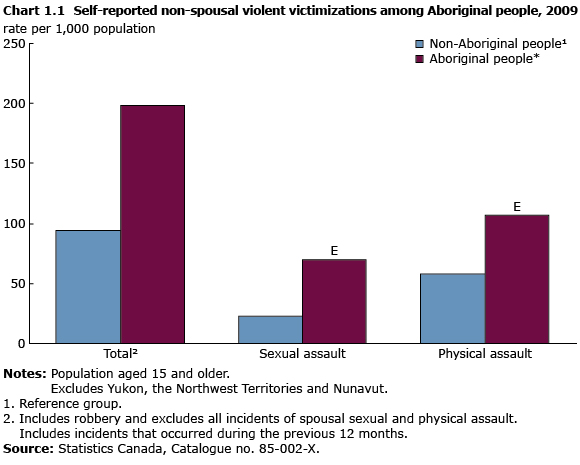Aboriginal peoples
Archived Content
Information identified as archived is provided for reference, research or recordkeeping purposes. It is not subject to the Government of Canada Web Standards and has not been altered or updated since it was archived. Please "contact us" to request a format other than those available.
Related information
In 2009, almost 322,000 Aboriginal people aged 15 and older (37% of the Aboriginal population in the provinces) self-reported having been a victim of at least 1 of 8 selected criminal offences in the past 12 months. Over the same period, 26% of non-Aboriginal people reported having been victimized.
Among Aboriginal people, theft of personal property was the most commonly reported of the offences (26%). Break and enter, theft of motor vehicles or parts, theft of household property and vandalism together accounted for one-third (33%). The rest of the incidents (41%) were violent crimes—physical assault, robbery and sexual assault.
Aboriginal people report being violently victimized
Aboriginal people were more than twice as likely as non-Aboriginal people to be the victim of non-spousal violence (12% versus 5%). In 2009, Aboriginal people reported 173,600 non-spousal violent incidents—198 for every 1,000 Aboriginal people, compared with 94 for every 1,000 non-Aboriginal people. Aboriginal people were also more likely to report being victimized multiple times (23% versus 19%).
Assaults were the most common type of non-spousal violent incident reported, at 107 incidents for every 1,000 Aboriginal people and 58 incidents for every 1,000 non-Aboriginal people. However, the gap between Aboriginal and non-Aboriginal victims is proportionally greater for sexual assaults (70 per 1,000 versus 23 per 1,000 people).
Young adults at highest risk
In 2009, nearly half (47%) of the victims of non-spousal violent incidents reported among Aboriginal people were aged 15 to 24, which was more than double this age group's representation (22%) in the Aboriginal population aged 15 and older.
Aboriginal people who reported using drugs at least once in the previous month had four times the risk of violent victimization compared with those who reported never using drugs. Aboriginal people living in areas where individuals using or selling drugs was a problem had a higher violent victimization rate than those who did not (277 per 1,000 versus 168 per 1,000). Also, in 67% of non-spousal violent incidents, the Aboriginal victim felt that it was related to the perpetrator's alcohol or drug use, compared with 52% among non-Aboriginal people.
The perpetrators of violent incidents are often known to the victims: 68% of Aboriginal victims and 52% of non-Aboriginal victims in 2009 knew the perpetrator. The larger proportion may be partly related to the higher incidence of sexual assault among Aboriginal people, as this type of offence is more likely to be committed by someone known to the victim than other forms of violence.
Most non-spousal violent victimizations are committed by young adult males. In 2009, about 3 out of 4 perpetrators of violent victimizations against Aboriginal people were male, and more than half (57%) were aged 25 to 44. Fewer of the violent incidents against Aboriginal people than against non-Aboriginal people involved a weapon (18% versus 30%).
Victimization of women
The rate of self-reported violent victimization among Aboriginal women was almost triple that of non-Aboriginal women. In 2009, 13% of the female Aboriginal population (aged 15 or older living in the provinces)—nearly 67,000 individuals—reported being the victim of one or more violent crimes in the previous 12 months; the majority were committed by males acting alone.
Nearly two-thirds (63%) of Aboriginal female victims were aged 15 to 34, yet this age group accounted for just under half (47%) of the female Aboriginal population. Young females were also over-represented among non-Aboriginal victims.
Of the violent incidents involving Aboriginal women that were committed by someone other than a spouse or common-law partner, 76% were not reported to the police, compared with 70% for non-Aboriginal women.
From 2004 to 2009, 15% of Aboriginal women reported a violent incident (physical or sexual assault) by a current or former spouse, compared with 6% of non-Aboriginal women.
Among Aboriginal victims of spousal violence, 59% reported being victimized more than once in the previous five years and 50% reported being victimized more than three times. By comparison, 43% of non-Aboriginal victims reported being victimized more than once and 29% more than three times.
- Date modified:

